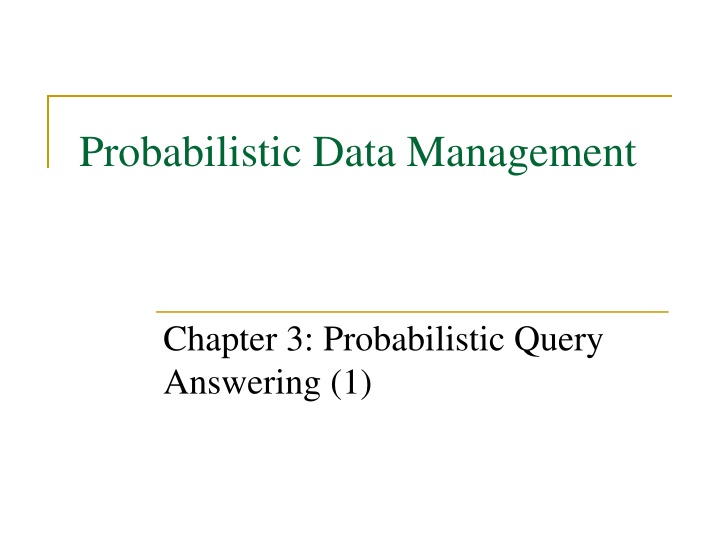
Efficient Techniques for Probabilistic Query Answering
Learn about the challenges of probabilistic query answering on uncertain data and discover basic techniques to efficiently answer different types of probabilistic queries. Explore frameworks and methodologies for enhancing query accuracy and effectiveness in managing uncertain data in real-world applications.
Download Presentation

Please find below an Image/Link to download the presentation.
The content on the website is provided AS IS for your information and personal use only. It may not be sold, licensed, or shared on other websites without obtaining consent from the author. If you encounter any issues during the download, it is possible that the publisher has removed the file from their server.
You are allowed to download the files provided on this website for personal or commercial use, subject to the condition that they are used lawfully. All files are the property of their respective owners.
The content on the website is provided AS IS for your information and personal use only. It may not be sold, licensed, or shared on other websites without obtaining consent from the author.
E N D
Presentation Transcript
Probabilistic Data Management Chapter 3: Probabilistic Query Answering (1)
Objectives In this chapter, you will: Learn the challenge of probabilistic query answering on uncertain data familiar with probabilistic query answering Become the framework for Explore the definitions of some basic probabilistic query types Become aware of basic techniques to efficiently answer different probabilistic queries 2
Outline Introduction Probabilistic Query Types Framework for Probabilistic Query Answering Query Answering Techniques for Different Probabilistic Queries Summary 3
Introduction In real applications, we need to deal with uncertain data Answering queries issued by users Location-based services (LBS) Business planning and decision making Anomaly or outlier detection Time-series database Aggregation Sensor networks 4
Introduction (cont'd) Challenges of the data manipulation over uncertain data The number of possible worlds over uncertain data is exponential w.r.t. the number of uncertain objects Two requirements Efficiency: Efficient query answering over possible worlds Effectiveness: Query answers should guarantee the accuracy 5
Outline Introduction Probabilistic Query Types Framework for Probabilistic Query Answering Query Answering Techniques for Different Probabilistic Queries Summary 6
Traditional Query Types Relational database Selection Projection Join Set difference Union Intersection 7
Traditional Query Types (cont'd) Spatial Query Spatial database Range query k-nearest neighbor (kNN) query Group nearest neighbor (GNN) query Reverse k-nearest neighbor (RkNN) query Spatial join /similarity join Top-k query (or ranked query) Skyline query Reverse skyline query Preference Query 8
Probabilistic Query Types Traditional query types usually assume the manipulation over certain and precise data In practice, these query types may be issued over uncertain data Due to the data uncertainty, traditional query types can no longer be applied to uncertain data 9
Probabilistic Query Types Probabilistic Spatial Query Uncertain/probabilistic database Probabilistic range query Probabilistic k-nearest neighbor query Probabilistic group nearest neighbor (PGNN) query Probabilistic reverse k-nearest neighbor query Probabilistic spatial join /similarity join Probabilistic top-k query (or ranked query) Probabilistic skyline query Probabilistic reverse skyline query Probabilistic Preference Query 10
Outline Introduction Probabilistic Query Types Framework for Probabilistic Query Answering Query Answering Techniques for Different Probabilistic Queries Summary 11
General Framework for Answering Probabilistic Queries Maintain a multidimensional index structure over uncertain database // indexing phase For each probabilistic query Apply the pruning methods during the index traversal // pruning phase Refine candidates and return the answer set // refinement phase 12
Outline Introduction Probabilistic Query Types Framework for Probabilistic Query Answering Query Answering Techniques for Different Probabilistic Queries Probabilistic Range Query Probabilistic k-Nearest Neighbor Query Summary 13
Probabilistic Range Queries in Uncertain Databases
Probabilistic Range Query A probabilistic range query(PRQ) retrieves a set of data objects oi which are in the query region, QR(q) , with probability pi greater than or equal to a threshold p ( 0) query region q 15
query region Probabilistic Range Query (cont'd) The probability pi of uncertain object oi is defined as the appearance probability of object oi falling into the query region QR(q) Discrete case pi = si oi si QR(q)si.p, where si is the sample of object oi and si.p is its existence probability Continuous case pi is given by the integral over oi ??= ?? ????.? ??. q 16
Applications of PRQ 1-dimensional sensor data Obtain sensors that have values within distance r from query point q, or within a bound [l, u] Cheng, R., Kalashnikov, D. V., Prabhakar, S. Evaluating probabilistic queries over imprecise data. In SIGMOD, 2003. 17
Exercises query point q Assume uncertain object o has a 2D rectangular uncertainty region of size 10 10, following Uniform distribution A query point q is at one corner of the uncertainty region, and the query radius is 5 What is the probability that object o is within the query region? 5 10 10 uncertain object o 18
Straightforward Approach for PRQ Query Answering To answer PRQ, it is not efficient to Check the intersection between every uncertain object and query region, and Compute the probability that the uncertain object falls into the intersection region Therefore, efficient pruning techniques are proposed in the literature 19
PRQ Processing Techniques (1D) 1D sensor data, probabilistic range query x-bound: a bound such that the probability that sensory data are on its left/right side is equal to x x-bound p = 0.3, Q is on RHS of B s right-0.3- bound Object B can be safely pruned Cheng, R., Xia, Y., Prabhakar, S., Shah, R., Vitter, J. S. Efficient indexing methods for probabilistic threshold queries over uncertain data. In VLDB, 2004. 20
PRQ Processing Techniques (1D, cont'd) 1D sensor data, probabilistic range query Map 1D uncertain interval [x, y] (Uniform distribution) to a 2D point (x, y), which is indexed by R-tree Interval query [a, b] 3-sided trapezoidal query x a < b y a x < b y x a < y b a < x < y < b Interval Query Probabilistic Threshold Query Cheng, R., Xia, Y., Prabhakar, S., Shah, R., Vitter, J. S. Efficient indexing methods for probabilistic threshold queries over uncertain data. In VLDB, 2004. 21
PRQ Processing Techniques (Multidimensional Case) PRQ on multidimensional uncertain data U-tree index Any dimensionality, range query, p-bound 0.2-bound pq2 = 0.2 pq1 = 0.8 Tao, Y., Cheng, R., Xiao, X., Ngai, W. K., Kao, B., Prabhakar, S. Indexing multi-dimensional uncertain data with arbitrary probability density functions. In VLDB, 2005. 22
Probabilistic Nearest Neighbor Queries in Uncertain Databases
Probabilistic Nearest Neighbor Query uncertain database e the nearest neighbor of query point qis: a a, b or d b, d object d has probability of being NN > q a d with maximum possible distance from q to a b c 25
Example (Nearest Neighbor Search) traditional database uncertain database e e q q a a d d b b c c a distance to q q d distance to q b q a d b c e c e 26
Probabilistic Nearest Neighbor Query Given a query point q, an uncertain database D, and a probabilistic threshold A probabilistic nearest neighbor(PNN) query retrieves all the uncertain objects o in D that are nearest neighbors of q with probability PPNN(q, o) greater than , that is, where r1 and r2 are the minimum and maximum distances from q to object o, respectively 27
Four Phases of PNNQ Processing 2. pruning phase 1. projection phase 3. bounding phase 4. evaluation phase Cheng, R., Kalashnikov, D. V., Prabhakar, S. Querying imprecise data in moving object environments. In TKDE, Vol. 16, No. 9, pp. 1112-1127, Sep 2004. 28
Variant of PNNQ PNNQ with uncertain query object Query object is an uncertain object E.g., in location based services, the position of a mobile user (query issue/object) is imprecise Double integral in the formula of probability: Discrete samples Indexing over samples Kriegel, H.-P., Kunath, P., Renz, M. Probabilistic nearest-neighbor query on uncertain objects. In DASFAA, 2007. 29
Essential Pruning Ideas Spatial Pruning Probabilistic Pruning 30
Spatial Pruning Basic idea Compute the lower/upper bounds of the distance, dist(q, o), from query point q to each uncertain object o at a low cost Use lower/upper bounds to filter out false alarms uncertain database e q a d b c 31
Spatial Pruning (cont'd) Obtain the smallest upper bound distance from q to objects we have seen so far as a threshold If the lower bound distance from q to any object o is greater than threshold, then object o can be safely pruned uncertain database e q a d b c 32
Example of Spatial Pruning uncertain database e threshold q a distance to q candidates q d a d b c b false alarms c e 33
Probabilistic Pruning (1- )-Hypersphere For any uncertain object o, we can pre- compute a hypersphere within its uncertainty region UR(o), such that object o resides in the hypersphere with probability (1- ), where [0, ] Basic idea Use (1- )-hypersphere to obtain the smallest upper bound distance from q to objects we have seen If the lower bound distance from q to any object o is greater than threshold, then object o can be safely pruned (1- ) - hypersphere o ( ) 1- ro 1- ro Co uncertainty region of data object o o ( ) UR 34
Probabilistic Pruning (1- ) - hypersphere a ( ) 1- uncertain database e q ra 1- ra Ca a d b uncertainty region of data object a a ( ) UR c 35
Probabilistic Pruning uncertain database e threshold q a distance to q candidates q d a d b false alarms c b c e 36
PNN Query Processing Maintain a multidimensional index structureover uncertain database For each PNN query // indexing phase Apply the spatial/probabilistic pruning methods during the index traversal // pruning phase Refine candidates and return the answer set // refinement phase 37
Probabilistic k-Nearest Neighbor Queries Generalization from 1NN to kNN A probabilistic k-nearest neighbor query (PkNNQ) retrieves a set of data objects oi that are the k- nearest neighbors of a query object q with nonzero probability pi (> 0) 38
Outline Introduction Probabilistic Query Types Framework for Probabilistic Query Answering Query Answering Techniques for Different Probabilistic Queries Summary 39
Summary In the scenario with uncertain data, queries need to be re-defined to probabilistic query types Challenges of probabilistic query answering Efficiency effectiveness 40
Summary (cont'd) Framework for answering probabilistic queries Indexing phase Pruning phase Refinement phase Probabilistic queries Probabilistic range query Probabilistic k-nearest neighbor (kNN) query 41

